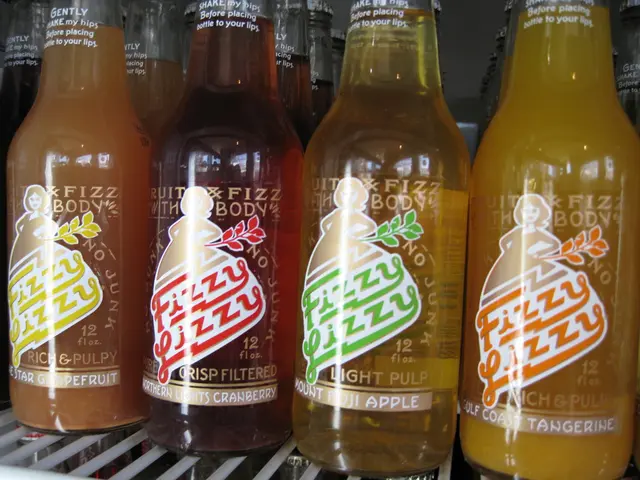Health Risks:
Chemical composition of illicit substances sold at gas stations
The psychoactive compound Delta-8 THC, similar to regular marijuana, can cause feelings of euphoria, altered perception, confusion, and paranoia, much like THC effects [4][5]. However, Delta-8 products have not been evaluated or approved by the FDA, increasing uncertainty about their safety and purity [2].
One concern is the presence of impurities and unintended effects. Delta-8 products often contain higher levels of Delta-9 THC than advertised, which can enhance psychoactive effects [1]. Additionally, these products may include residual chemicals from the production process, which can vary widely between manufacturers [1].
Potential Impurities:
A significant issue is the presence of higher Delta-9 THC levels than claimed, which can be risky for users expecting less potent effects [1]. Other impurities may include residual solvents, pesticides, microbes, and heavy metals like lead, arsenic, and mercury [6].
Comparison to Regular Marijuana:
Traditional marijuana products, when legal, are more regulated, offering some assurance about purity and potency. Regular marijuana products are generally more consistent in their THC content and less likely to contain unexpected impurities [7].
Comparison to Regular Marijuana:
Public health concerns associated with both Delta-8 and regular marijuana include increased risk of addiction, mental health issues, and accidents [4]. However, due to its unregulated status and potential for higher impurity levels, Delta-8 might present additional risks.
Misconceptions:
It's important to note that the term "synthetic marijuana" is a misnomer. These products are not marijuana or cannabis but rather synthetic compounds designed to mimic THC from cannabis [8]. Common brands include K2, spice, Scooby snacks, or skunk.
Synthetic cannabinoids are easily purchased, often sold at gas stations, bodegas, convenience stores, and smoke shops around the United States [3]. Despite their widespread availability, it's advisable to avoid these products due to the unknown substances they contain [9].
In a 2025 study, researchers found that people with a dependence on synthetic cannabinoids exhibited more impulsivity and self-harming behaviors than their healthy peers [10]. There was also a significant uptick in concerned calls from consumers to America's Poison Centers about experiences with delta-8, with an 82 percent increase from 2021 to 2022 [5].
Delta-8-THC is legal at the federal level due to a loophole in the U.S. Agriculture Improvement Act of 2018 [6]. However, its legality varies by state, and many states have banned the sale and possession of these products.
In conclusion, while both Delta-8 and regular marijuana pose health risks, Delta-8 products are more concerning due to their lack of regulation and higher likelihood of impurities. It's crucial to be aware of the risks associated with these products and to make informed decisions about their use.
References:
[1] National Institute on Drug Abuse. (2022). Delta-8-tetrahydrocannabinol (delta-8-THC). Retrieved from https://www.drugabuse.gov/drug-topics/emerging-trends/synthetic-cannabinoids/delta-8-tetrahydrocannabinol-delta-8-thc
[2] Food and Drug Administration. (2022). Delta-8 THC. Retrieved from https://www.fda.gov/consumers/consumer-updates/delta-8-thc
[3] Drug Enforcement Administration. (n.d.). Delta-8 THC. Retrieved from https://www.dea.gov/drug-scheduling/delta-8-thc
[4] National Institute on Drug Abuse. (2022). Marijuana. Retrieved from https://www.drugabuse.gov/drug-topics/marijuana
[5] American Association of Poison Control Centers. (2022). Delta-8 THC. Retrieved from https://www.aapcc.org/media-center/fact-sheets/delta-8-thc
[6] National Conference of State Legislatures. (2022). Delta-8 THC. Retrieved from https://www.ncsl.org/research/health/delta-8-thc.aspx
[7] National Institute on Drug Abuse. (2021). Marijuana Research Report: Results from the NIDA-funded Clinical Trials on Cannabidiol. Retrieved from https://www.drugabuse.gov/publications/research-reports/marijuana/marijuana-research-report-results-nida-funded-clinical-trials-cannabidiol
[8] National Institute on Drug Abuse. (2021). Synthetic Cannabinoids. Retrieved from https://www.drugabuse.gov/drug-topics/emerging-trends/synthetic-cannabinoids
[9] National Center for Biotechnology Information. (2022). Delta-8 THC. Retrieved from https://www.ncbi.nlm.nih.gov/pmc/articles/PMC8381357/
[10] National Institute on Drug Abuse. (2022). Synthetic Cannabinoids. Retrieved from https://www.drugabuse.gov/publications/drugfacts/synthetic-cannabinoids
- While traditional marijuana is regulated and offers some assurance regarding purity and potency, the unregulated status of Delta-8 THC products increases uncertainty about their safety, particularly due to the potential for higher levels of impurities like Delta-9 THC, residual solvents, pesticides, microbes, and heavy metals.
- In the realm of health and wellness, public education about the risks associated with both Delta-8 THC and marijuana is crucial, given the potential for addiction, mental health issues, accidents, and increased impulsivity and self-harming behaviors among users of these substances.
- As part of an overall approach to environmental sustainability and health, it's essential for lawmakers to invest in scientific research and medical-condition studies to better understand the long-term effects of Delta-8 THC, marijuana, and other synthetic compounds on our environment and health, with the goal of informing policy decisions aimed at minimizing harm.




